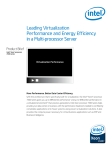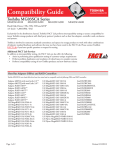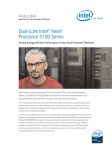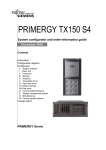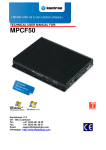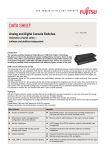Download Intel Quad-core Xeon X3230
Transcript
Product Brief Intel® Xeon® Processor 3000 Sequence Quad-Core and Dual-Core Intel® Xeon® Processor 3000 Sequence-based Platforms Entry-Level Servers with outstanding dependability, performance and value Your next move to new business efficiency, productivity and opportunity Take your business to new levels with server platforms based on the Quad-Core and Dual-Core Intel® Xeon® processor 30001 sequence and the Intel® 3200 chipsets. These servers can unleash the computing power of the new Quad- or Dual-Core Intel Xeon processor based on Intel® Core™ microarchitecture to help provide your business with industry-leading performance for entry-level business servers. Intel Core microarchitecture enables lower power consumption than previous generations of Intel® platforms based on Intel® Pentium® processors, resulting in lower operating costs and reduced fan noise. The faster 800 MHz DDR2 memory speed available with Intel 3200 chipset can offer higher performance than previous-generation Intel 3000 chipset. Intel Xeon processor 3000 sequence-based entry-level servers are designed with utility and versatility in mind. They are ideal for small business owners looking for ways to grow business, manage operations more effectively and efficiently, and protect and secure one of their most important assets – information. Intel® Xeon® processor-based entry-level servers build in proven performance, manageability and reliability, allowing you to spend more time on moving your business forward. Trust your company to Intel’s proven server technology With nearly 40 million Intel® processor-based servers shipped since 1996, and a 20-year track record of delivering enterprise-class performance, more companies trust their businesses to Intel processor-based servers. Intel processor-based entry-level servers give companies the reliability, performance, and tools they need to focus on their business instead of their computers. Our entry-level server platforms are comprehensive solutions. We combine effective technologies, software, and industry alliances to give you servers optimized for your business with incredible value. You can count on Intel to deliver superior quality and reliability to drive your business forward. The ideal entry-level server Our entry-level server platforms with quad- or dual-core processors and the Intel 3200 chipsets are ideal for value-conscious organizations looking for their first server or small HPC cluster with a close eye on their budget. These platforms offer industry-leading performance coupled with Intel reliability to help drive your big ideas non-stop, and are dependable, efficient to set up and manage, provide trouble-free operation and help ensure that your operational needs are met at every stage of your business growth. Our entry-level server platforms integrate the most advanced technologies: • Quad-Core Intel® Xeon® processor 32001 series or Dual-Core • Intel® PRO/1000 PM/PL network connections provide gigabit Intel Xeon processor 3000 series are based on Intel Core Ethernet LAN connectivity for high-speed network access. 1 microarchitecture, with Intel® 64 Architecture2 and up to 1333 MHz front-side bus for dual-core. These processors deliver outstanding performance for today’s business applications, capabilities to run a broad range of 32-bit and 64-bit applications, and plenty of headroom for growth for tomorrow. • Power-efficient performance designed into the platform to help reduce operating costs while delivering higher performance than previous-generation Intel Pentium processor-based server platforms. Lower power consumption can also result in slower fans and quieter servers. • Intel® Matrix Storage Technology quickly stores and retrieves data, while protecting one of your company’s most important assets – information – with RAID 0, 1, 5, and 10 technology. • PCI Express,* today’s mainstream I/O technology, helps enable fast I/O transactions to assist peripherals to keep up with our high-performance processors and chipsets, and builds in scalability for the future. The Intel® 3210 chipset offers an additional PCI Express I/O for even more expansion possibilities. • Intel® Virtualization Technology3 provides hardware assist to virtualization software, enabling your servers to support both 32-bit and 64-bit operating systems and applications on the same server. Implementing virtualization enables businesses to get the most out of server investment by running more applications on each server. • Up to 8 GB of high-speed 800 MHz dual-channel DDR2 memory with Intel 3200 chipset keeps more data closer to the processor and helps eliminate slowdowns from memory bottlenecks. Protect your critical data Platforms based on the Intel 3200 chipsets support Error Correction Code (ECC) memory for a high level of data integrity, reliability, and system uptime. ECC can detect multiple-bit memory errors and locate and correct single-bit errors to keep business applications running smoothly. Intel Matrix Storage Technology with integrated RAID 0, 1, 5, or 10 accelerates data access to support high user productivity, and helps protect business operations by allowing recovery of data. Intel Matrix Storage Technology is built into the Intel® 82801IR I/O controller hub (ICH9R). The ICH9R also supports both Serial ATA (SATA) at 3 GB/s with Native Command Queuing for high-speed disk access, and legacy parallel hard drive interfaces for versatility in a high-performance, entry-level server platform. Cost-effective, personal supercomputing Personal or workgroup clusters based on the Intel Xeon processor 3000 sequence offer an alternative for scientists and researchers who normally have to share supercomputer or large-scale computing power within a laboratory or a company. Personal or workgroup clusters allow scientists and researchers to be more productive by allowing them to complete tasks on a local cluster more efficiently and conveniently than on larger, shared, computer clusters. In addition to both convenience and productivity, scientists and researchers can gain performance capability to help process their applications or simulations at a fraction of the cost of a full-scale supercomputer. These new platforms provide energy-efficient performance to help you get high-end performance for thin or thick nodes at low power levels, helping to keep the costs of running your personal cluster low. The Intel Xeon processor 3000 sequence-based servers give you essential server technologies to help improve your reliability and data protection. They can help you solve tough problems for Entry-level quad- or dual-core Intel server platforms are ideal less cost than traditional cluster technologies with the dependabil- for building small, cost-effective HPC clusters that create high- ity and integrity of Intel’s 20-year track record for delivering reliable, performance, personal supercomputing solutions, or workgroup high-performance solutions. clusters. 64-bit computing, up to 8 GB of high-speed DDR2 memory per processor, and gigabit Ethernet LAN connectivity enable rapid solutions of the large, complex problems found in technical computing. Quad-Core and Dual-Core Intel® Xeon® Processor-based Platforms Overview Platform Feature User Benefit Quad-Core Intel® Xeon® processor 32001 series •Based on Intel Core microarchitecture •64-bit, quad-core computing with large 8 MB on-die cache •1066 MHz front-side bus Dual-Core Intel® Xeon® processor 30001 sequence •Based on Intel Core microarchitecture • 64-bit computing •New 1333 and 1066 MHz front-side bus Intel® Core™ microarchitecture •Better performance on multiple application types and user environments at a substantially reduced power envelope 1066 MHz and 1333 MHz front-side buses •Up to 8.6 GB/s with 1066 MHz and up to 10.6 GB/s with 1333 MHz Dual-channel DDR2 memory with ECC •Up to 8 GB dual-channel DDR2 Error Correcting Code (ECC) memory with Intel® 3200 chipset that checks and corrects many common system memory errors Intel® 64 Architecture2 •Enables extended memory addressability for server applications Intel® Virtualization Technology3 for directed I/O •Enables more operating systems and software to run in today’s virtual environments •Developed with virtualization software providers to enable greater functionality and compatibility compared to nonhardware-assisted virtual environments •Intel® Virtualization Technology provides hardware assist to virtualization software, enabling your servers to support both 32-bit and 64-bit operating systems and applications on the same server. Implementing virtualization enables businesses to get the most out of server investment by running more applications on each server. PCI Express* serial I/O •Industry-standard serial I/O capable of up to 4 GB/s peak bandwidth with x8 link with Intel 3200 chipset Find out more about Quad-Core Intel® Xeon® processors at www.intel.com/products/ processor/xeon What is the 3000 Sequence? At Intel, our processor sequence numbers are intended to help clarify processor features, capabilities and intended usages. Intel offers four processor number sequences for server applications: • Quad-Core and Dual-Core Intel® Xeon® processor 3000 • Quad-Core and Dual-Core Intel® Xeon® processor 7000 sequence: One-processor servers for small business, entry, sequence: Greater scalability with 4- to 32-processor or first server based on the Intel Xeon processor enterprise servers based on the Intel Xeon processor. • Quad-Core and Dual-Core Intel® Xeon® processor 5000 • Dual-Core Intel® Itanium® processor 9000 sequence: sequence: Two-processor general-purpose, standard high- Maximum performance and scalability for RISC replace- volume servers, HPC systems, and workstations based on ment usage with 2- to 512-processor servers. the Intel Xeon processor Quad-Core Intel® Xeon® Processor 3200 Series Quad-Core Intel Xeon processor 3200 series is based on Intel Core microarchitecture, integrates an 8 MB L2 cache, Intel Virtualization Technology, and Intel 64 Architecture. Intel Xeon 3200 processor series provides significant performance headroom, especially for multithreaded applications, helps boost system utilization through virtualization and application responsiveness. TDPb Intel® Virtualization Technology3 Intel® 64 Intel® Architecture2 EIST Package 1066 MHz 95W Yes Yes Yes LGA775 8 MB 1066 MHz 95W Yes Yes Yes LGA775 8 MB 1066 MHz 95W Yes Yes Yes LGA775 Processor Number1 CPU Frequency Cache Sizea Front Side Bus Quad-Core Intel® Xeon® Processor X3230 2.66 GHz 8 MB Quad-Core Intel® Xeon® Processor X3220 2.4 GHz Quad-Core Intel® Xeon® Processor X3210 2.13 GHz a Features 4 MB Smart Cache per core pair Thermal Design Power b Dual-Core Intel® Xeon® Processor 3000 Series Dual-Core Intel Xeon processor 3000 series is based on Intel Core microarchitecture, integrates a 4 MB shared L2 cache, Intel Virtualization Technology, and Intel 64 Architecture. Economic, dependable Dual-Core Intel Xeon processor 3000 series-based servers deliver solid computing performance for entry-level servers without compromising affordability. TDPa Intel® Virtualization Technology3 Intel® 64 Intel® Architecture2 EIST Package 1333 MHz 65W Yes Yes Yes LGA775 4 MB 1333 MHz 65W Yes Yes Yes LGA775 4 MB 1333 MHz 65W Yes Yes Yes LGA775 2.66 GHz 4 MB 1066 MHz 65W Yes Yes Yes LGA775 2.4 GHz 4 MB 1066 MHz 65W Yes Yes Yes LGA775 Dual-Core Intel® Xeon® Processor 3050 2.13 GHz 2 MB 1066 MHz 65W Yes Yes Yes LGA775 Dual-Core Intel® Xeon® Processor 3040 1.86 GHz 2 MB 1066 MHz 65W Yes Yes Yes LGA775 Processor Number1 CPU Frequency Cache Size Front-Side Bus Dual-Core Intel® Xeon® Processor 3085 3.0 GHz 4 MB Dual-Core Intel® Xeon® Processor 3075 2.66 GHz Dual-Core Intel® Xeon® Processor 3065 2.33 GHz Dual-Core Intel® Xeon® Processor 3070 Dual-Core Intel® Xeon® Processor 3060 a Thermal Design Power Breakthrough Performance with Intel® Core™ Microarchitecture Combining high-performance design with power-efficient technologies, the Intel Core microarchitecture is a foundation for new energy-efficient platforms. Intel Core microarchitecture technologies deliver higher performance/watt compared to previous Intel microarchitectures. Intel® Wide Dynamic Execution. Executes more instructions per Intel® Advanced Smart Cache. A large on-die cache that reduces clock with as much as a 33 percent wider execution path for each latency to data, helping to improve performance and power efficiency. processor core compared to previous Intel microarchitectures. Intel® Advanced Digital Media Boost. Executes complete 128-bit Intel® Intelligent Power Capability. Manages power consump- instructions in one clock cycle instead of two cycles, as in previous tion of all execution units in the core to help optimize energy usage. microarchitectures, for improved performance of streaming instructions (SSE/SSE2/SSE3). Compute-Intensive Throughput General-Purpose Server Technical Computing General Purpose Java* Application Server Energy Efficiency Est. SPECfp*_rate_base2006 Est. SPECint*_rate_base2006 SPECjbb* 2005 bops Dual-Core performance/watt 2.9 2.4 2.1 1.9 1.8 1.7 1.5 1.6 1.4 1.4 1.2 1.0 1.0 1.0 Intel® Pentium® D Processor 945 Intel® Xeon® Processor 3070 Intel® Xeon® Processor 3085 Intel® Xeon® Processor X3230 1.0 Intel® Pentium® D Processor 950 Intel® Xeon® Processor 3070 Intel® Xeon® Processor 3085 Intel® Xeon® Processor X3230 Intel® Pentium® D Processor 945 Intel® Xeon® Processor 3070 Intel® Xeon® Processor 3085 Intel® Xeon® Processor X3230 AMD Opteron* Processor 1220SE Intel® Xeon® Processor 3070 Intel® Xeon® Processor 3085 High-Performance Computing (HPC) Server Fluent* 6.3.33 LS-Dyna* mpp971 Amber* 9 8/9 workloads 3 cars @ 30ms 8 workloads 2.3 1.7 1.6 1.4 1.3 1.2 1.0 1.0 1.0 AMD Opteron* Processor 1220SE Intel® Xeon® Processor 3085 Intel® Xeon® Processor X3230 AMD Opteron* Processor 1220SE Intel® Xeon® Processor 3085 Intel® Xeon® Processor X3230 AMD Opteron* Processor 1220SE Intel® Xeon® Processor 3085 Intel® Xeon® Processor X3230 For more information on performance, please visit www.intel.com/performance Server and HPC Performance •Benchmark Description for SPECcpu*2006 suite (SPECint*_rate_base2006 & SPECfp*_rate_base2006): SPEC CPU2006 is the industry-adopted, CPU-intensive benchmark which stresses the system processor(s), memory subsystem, and compiler. Derived from 29 real user applications, CPU2006 provides a comparison across the widest practical range of hardware reporting a geometric mean ratio score on a baseline compiled binary. •Best 1-socket server SPECint_rate_base2006* (score) benchmark results as of 15 Oct 2007: –Intel® Pentium® D Processor platform (score 20.6): Fujitsu-Siemens PRIMERGY* RX100S4 using Intel Pentium D processor 945 (3.40 GHz, 2x2 MB L2 cache, 800 MHz bus), 8 GB (4x 2 GB DDR2 PC4200E, 2-rank, CL4, ECC), 64-bit SuSE LINUX* Enterprise Server 10 2.6.16.21-08smp, Intel® C++ Compiler for IA32/EM64T version 9.1. Source: http://www.spec.org/cpu2006/results/res2007q3/cpu2006-20070619-01287.html. –Dual-Core Intel® Xeon® Processor 3070 platform (score 29.3): Fujitsu-Siemens PRIMERGY* RX100S4 using Intel Xeon processor 3070 (2.66 GHz, 4 MB L2 cache, 1066 MHz bus), 8 GB (4x 2 GB DDR2 PC4200E, 2-rank, CL4, ECC), 64-bit SuSE LINUX* Enterprise Server 10 2.6.16.21-08smp, Intel® C++ Compiler for IA32/EM64T version 9.1. Source: http://www.spec.org/cpu2006/results/res2007q2/cpu2006-20070514-01066.html. –Dual-Core Intel® Xeon® Processor 3085 platform (score 35.3): Intel® SR1530HSH using Intel Xeon processor 3085 (3.00 GHz, 4 MB L2 cache, 1333 MHz bus), 8 GB (4x 2GB DDR2-800), SUSE Linux10* SP1 RC5, Intel® C++ Complier Compiler version 10.1. Source: Intel internal measurements TR#824. –Quad-Core Intel® Xeon® Processor X3230 platform (score 48.5): Intel® SR1530HSH using Intel Xeon processor X3230 (2.66 GHz, 8 MB L2 cache, 1066 MHz bus), 8 GB (4x 2GB DDR2-800), SUSE Linux10* SP1 RC5, Intel® C++ Complier Compiler version 10.1. Source: Intel internal measurements TR#824. • Best 1-socket server SPECfp_rate_base2006* (score) benchmark results as of 15 Oct 2007: –Intel® Pentium® D Processor platform (score 19.8): Fujitsu-Siemens PRIMERGY* RX100S4 using Intel Pentium D processor 945 (3.40 GHz, 2x2 MB L2 cache, 800 MHz bus), 8 GB (4x 2 GB DDR2 PC4200E, 2-rank, CL4, ECC), 64-bit SuSE LINUX* Enterprise Server 10 2.6.16.21-08smp, Intel® C++ Compiler for IA32/EM64T version 9.1. Source: http://www.spec.org/cpu2006/results/res2007q3/cpu2006-20070619-01288.html. –Dual-Core Intel® Xeon® Processor 3070 platform (score 25.3): Acer Altos* G330 using Intel Xeon processor 3070 (2.66 GHz, 4 MB L2 cache, 1066 MHz bus), 4 GB (4x 1 GB DDR2-667, CL5, ECC), 64-bit SuSE LINUX* Enterprise Server 10 2.6.16.21-08smp, Intel® C++ Compiler for IA32/EM64T version 9.1. Source: http://www.spec.org/cpu2006/results/res2007q2/cpu2006-20070429-00964.html. –Dual-Core Intel® Xeon® Processor 3085 platform (score 29.7): Intel® SR1530HSH using Intel Xeon processor 3085 (3.00 GHz, 4 MB L2 cache, 1333 MHz bus), 8 GB (4x 2GB DDR2-800), SUSE Linux10* SP1 RC5, Intel® C++ Complier and Fortran Compiler version 10.1. Source: Intel internal measurements TR#824. –Quad-Core Intel® Xeon® Processor X3230 platform (score 35.2): Intel® SR1530HSH using Intel Xeon processor X3230 (2.66 GHz, 8 MB L2 cache, 1066 MHz bus), 8 GB (4x 2GB DDR2-800), SUSE Linux10* SP1 RC5, Intel® C++ Complier and Fortran Compiler 10.1. Source: Intel internal measurements TR#824. •Benchmark Description for SPECjbb*2005: SPEC Java Business Benchmark 2005 (jbb2005). Written in Java, this multi-threaded benchmark emulates an order processing environment in a company with multiple warehouses serving multiple customers. Measures average transaction throughput of a heavily loaded server. Performance reported in Business Operations per Second (BOPS). • Best 1-socket server SPECjbb2005* (bops) benchmark results as of 15 Oct 2007: –Intel® Pentium® D Processor platform (score 34,111): Fujitsu-Siemens PRIMERGY* TX150S4 using Intel® Pentium® D Processor 950 (3.40 GHz, 800 MHz bus, 2x 2 MB L2 cache), 8192 MB RAM, Microsoft Windows* Server 2003 Enterprise x64-Edition SP1 (64-bit), BEA JRockit* P26.0.0-35-59328-1.5.0_06-20060321-1333-win-x86_64. Source: http://www.spec.org/osg/jbb2005/results/res2006q2/jbb2005-20060425-00108.html. –Intel® Xeon® Processor platform (3070 score 65,656/avg sys watts 132; 3085 score 73,275/avg sys watts 131; X3230 score 97,434/avg sys watts 196): Intel “Garlow” 3210 Chipsetbased server platform BIOS 8/31/2007 using Intel® Xeon® Processor 3070 (2.66 GHz, 4 MB cache, 1066 FSB), 3085 (3.00 GHz, 4 MB cache, 1333 FSB), and X3230 (2.66 GHz, 8 MB cache, 1066 FSB), 4x 2 GB DDR2-800 ECC CL5 DIMMs, 120 GB SATA HDD, Microsoft Windows* Server 2003 Enterprise x64-Edition SP1 (64-bit), SPECjbb* V1.07, BEA JRockit* P27.4.0. Source: Intel internal measurements TR#825. –AMD Opteron* Processor platform (score 58,189/avg sys watts 162): Hewlett-Packard ML115G1* using AMD Opteron* Processor 1220SE (2.80 GHz), 4x 2 GB DDR2-800 ECC CL5 DIMMs, 120 GB SATA HDD, Microsoft Windows* Server 2003 Enterprise x64-Edition SP1 (64-bit), SPECjbb* V1.07, BEA JRockit* P27.4.0. Source: Intel internal measurements TR#825. •Benchmark Description for Fluent*: Fluent is a commercial engineering application used to model computational fluid dynamics. The benchmark consists of 9 standard workloads organized into small, medium and large models. These comparisons use all but the largest of the models which does not fit into the 8GB of memory available on the platforms. The Rating, the default Fluent metric, was used in calculating the ratio of the platforms by taking a geometric mean of the 8 workload ratings measured. • Best 1-socket Fluent* version 6.3.33 (8 of the 9 standard, jobs/day) benchmark results as of 15 Oct 2007: –Intel® Xeon® Processor platform (3085 score 1611.1/avg sys watts 131; X3230 score 2247.7/avg sys watts 192): Intel “Garlow” 3210 Chipset-based server platform BIOS 8/31/2007 using Intel® Xeon® Processor 3085 (3.00 GHz, 4 MB cache, 1333 FSB) and X3230 (2.66 GHz, 8 MB cache, 1066 FSB), 4x 2 GB DDR2-667 ECC CL5 DIMMs, 120 GB SATA HDD, Red Hat Enterprise LINUX* 64-bit. Source: Intel internal measurements TR#823. –AMD Opteron* Processor platform (score 1287.2/avg sys watts 164): Hewlett-Packard ML115G1* using AMD Opteron* Processor 1220SE (2.80 GHz), 4x 2 GB DDR2-667 ECC CL5 DIMMs, 120 GB SATA HDD, Red Hat Enterprise LINUX* 64-bit. Source: Intel internal measurements TR#823. •Benchmark Description for LS-Dyna*: LS-DYNA is a commercial engineering application used in finite element analysis such as a car collision. The workload used in these comparisons is called 3 Vehicle Collision and is publicly available from www.topcrunch.org/. The metric for the benchmark is elapsed time in seconds. • Best 1-socket LS-Dyna* version mpp971.7600.2.398 (3 cars@30ms, jobs/day) benchmark results as of 15 Oct 2007: –Intel® Xeon® Processor platform (3085 score 6.63/avg sys watts 136; X3230 score 8.96/avg sys watts 194): Intel “Garlow” 3210 Chipset-based server platform BIOS 8/31/2007 using Intel® Xeon® Processor 3085 (3.00 GHz, 4 MB cache, 1333 FSB) and X3230 (2.66 GHz, 8 MB cache, 1066 FSB), 4x 2 GB DDR2-667 ECC CL5 DIMMs, 120 GB SATA HDD, Red Hat Enterprise LINUX* 64-bit. Source: Intel internal measurements TR#823. –AMD Opteron* Processor platform (score 5.67/avg sys watts 167): Hewlett-Packard ML115G1* using AMD Opteron* Processor 1220SE (2.80 GHz), 4x 2 GB DDR2-667 ECC CL5 DIMMs, 120 GB SATA HDD, Red Hat Enterprise LINUX* 64-bit. Source: Intel internal measurements TR#823. •Benchmark Description for Amber*: a package of molecular simulation programs. The workload measures the number of problems solved per day (PS) using eight standard molecular dynamic simulations. See http://amber.ch.ic.ac.uk/amber8.bench1.html for more information. • Best 1-socket Amber* version 9 (8 standard, PS/day) benchmark results as of 15 Oct 2007: –Intel® Xeon® Processor platform (3085 score 305.5/avg sys watts 134; X3230 score 491.9/avg sys watts 204): Intel “Garlow” 3210 Chipset-based server platform BIOS 8/31/2007 using Intel® Xeon® Processor 3085 (3.00 GHz, 4 MB cache, 1333 FSB) and X3230 (2.66 GHz, 8 MB cache, 1066 FSB), 4x 2 GB DDR2-667 ECC CL5 DIMMs, 120 GB SATA HDD, Red Hat Enterprise LINUX* 64-bit. Source: Intel internal measurements TR#823. –AMD Opteron* Processor platform (score 212.8/avg sys watts 164): Hewlett-Packard ML115G1* using AMD Opteron* Processor 1220SE (2.80 GHz), 4x 2 GB DDR2-667 ECC CL5 DIMMs, 120 GB SATA HDD, Red Hat Enterprise LINUX* 64-bit. Source: Intel internal measurements TR#823. SPECint*2006 and SPECfp*2006 benchmark tests reflect the performance of the microprocessor, memory architecture and compiler of a computer system on compute-intensive, 32-bit or 64-bit applications. SPEC benchmark tests results for Intel microprocessors are determined using particular, well-configured systems. These results may or may not reflect the relative performance of Intel microprocessor in systems with different hardware or software designs or configurations (including compilers). Buyers should consult other sources of information, including system benchmarks, to evaluate the performance of systems they are considering purchasing. SPECcpu*2006 suite including SPECint2006 and SPECfp2006 are registered trademarks of the Standard Performance Evaluation Corporation (SPEC). 1 Intel processor numbers are not a measure of performance. Processor numbers differentiate features within each processor series, not across different processor sequences. See http://www.intel.com/products/processor_number for details. 2 64-bit computing on Intel architecture requires a computer system with a processor, chipset, BIOS, operating system, device drivers and applications enabled for Intel® 64 architecture. Performance will vary depending on your hardware and software configurations. Consult with your system vendor for more information. 3 Intel Virtualization Technology requires a computer system with a processor, chipset, BIOS, virtual machine monitor (VMM) and applications enabled for virtualization technology. Functionality, performance or other virtualization technology benefits will vary depending on hardware and software configurations. Virtualization technology-enabled BIOS and VMM applications are currently in development. Performance tests and ratings are measured using specific computer systems and/or components and reflect the approximate performance of Intel products as measured by those tests. Any difference in system hardware or software design or configuration may affect actual performance. Buyers should consult other sources of information to evaluate the performance of systems or components they are considering purchasing. For more information on performance tests and on the performance of Intel products, visit www.intel.com/performance/resources/limits.htm or call (U.S.) 1-800-628-8686 or 1-916-356-3104. All dates and products specified are for planning purposes only and are subject to change without notice. Relative performance for each benchmark is calculated by taking the actual benchmark result for the first platform tested and assigning it a value of 1.0 as a baseline. Relative performance for the remaining platforms tested was calculated by dividing the actual benchmark result for the baseline platform into each of the specific benchmark results of each of the other platforms and assigning them a relative performance number that correlates with the performance improvements reported. Information in this document is provided in connection with Intel products. No license, express or implied, by estoppel or otherwise, to any intellectual property rights is granted by this document. Except as provided in Intel’s Terms and Conditions of Sale for such products, Intel assumes no liability whatsoever, and Intel disclaims any express or implied warranty, relating to sale and/or use of Intel products including liability or warranties relating to fitness for a particular purpose, merchantability, or infringement of any patent, copyright or other intellectual property right. Intel products are not intended for use in medical, life saving, or life sustaining applications. Intel may make changes to specifications and product descriptions at any time, without notice. *Other names and brands may be claimed as the property of others. Copyright © 2007 Intel Corporation. All rights reserved. Intel, the Intel logo, Intel. Leap ahead., Intel. Leap ahead. logo, Xeon, Intel Core, and Pentium are trademarks of Intel Corporation in the U.S. and other countries. Printed in USA 1107/VL/OCG/XX/PDF Please Recycle 318152-001US











